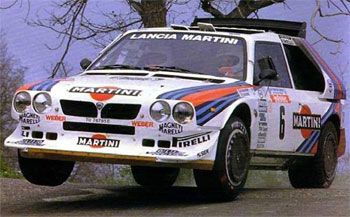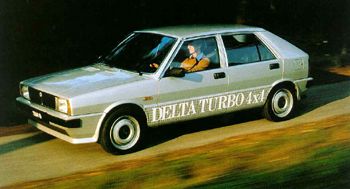|
A substantial reworking of the Ritmo’s floorplan
also meant that Beta-derived MacPherson struts on all four
corners (with twin transverse links at the rear) were
substituted in favour of the Fiat’s standard MacPherson
front/transverse leaf spring and wishbone rear suspension
– a recognisable nod to its Beta and Gamma bigger
brothers, but a move which also benefited handling.
This
was useful, as the eighties trend towards turbocharging
didn’t take long to manifest itself in various
developments of Lancia’s baby.
In 1983, a turbocharged version of the Beta’s 1.6
twin-cam appeared developing 130 bhp, later upgraded to 140
bhp with the addition of fuel injection in 1986.
But these improvements were to be overshadowed by a
much more significant development.
The
image of the Delta had received a timely fillip towards the
end of 1985, six years into its life, when the Delta S4 was
let loose onto the world’s rally stages on the
end-of-season, and extremely demanding, Lombard RAC Rally.
Like all Group B cars, the relationship between the
road car and its competition counterpart was next to
nonexistent – Abarth even designed an all-new twin-cam
16-valve engine, with both a turbocharger and supercharger
to reduce the effects of low-down turbo lag, mid-mounted and
driving all four wheels, some way from a humble road-going
Delta. But while
there may have been little relation, the car was certainly
effective, winning its first-ever special stage and sweeping
to a one-two finish on its very first outing, Henri Toivonen
leading home long-time Fiat/Lancia exponent Markku Alen.
It seemed after that performance that 1986 would be full of promise,
but it was to be a scenario that would not be fulfilled. After taking a superb win on the Monte Carlo rally in
January of that year and leading in Sweden prior to engine
failure, Toivonen and Lancia arrived in Corsica at the
beginning of May searching for a win.
Leading from the off, Toivonen and co-driver Sergio
Cresto built up a commanding lead, until on the second day
– a year to the day when another works Lancia pilot,
Attilio Bettega, was killed on the same rally in an 037 – their S4 plunged off the road and exploded, killing both
crew members, in an accident that has never been fully
explained. Lancia
immediately withdrew from the rally, and although it
continued to fight on in both championships, it was left on
the back foot.
|
 |
|
The
all-wheel-drive S4 rally car launched the Delta
into legendary status in 1985, sweeping a 1-2
finish on its very first outing. |
|
 |
|
|
 |
| Lancia
brought rally technology to the road with the
Delta Turbo 4x4. |
|
 |
|
|
It
was not until Argentina that a change in tyre size meant that
the other pilots, such as Alen and Biasion, were truly able
to come to grips with the S4, by which time Peugeot had
already built up a sizeable lead in the manufacturer’s
title race. Despite
this, the car was competitive enough to keep Alen in the
title fight until after the final round, when a courtroom
decision handed the championship to Peugeot’s Juha Kankkunen.
It
seems amazing to think now that an all-new Delta was
pencilled in for a 1988 launch.
In fact, excluding the Integrale, production of the
original car ceased in 1993, five years later – almost the
full life of the average car.
The Delta may have been a fundamentally decent car,
but by the mid-eighties it was ageing and sales were
starting to tail off. It
was Fiat’s giant publicity campaign which rescued it from
death’s clutches – and more specifically, Lancia’s
determination to dominate the special stages of the world.
The
death of Group B rallying at the end of 1986 was clearly
necessary on safety grounds, but overreaction by FISA meant
that the proposed Group S category (effectively quite
similar to the world rally cars seen nowadays, with cars
limited to 300 bhp) was killed off as well in favour of the
production-based Group A.
Lancia had already readied the carbon-fibre and Kevlar
ECV1 prototype, a Group S contender loosely based around the
S4, but found that their newly-released Delta HF 4WD fitted
the bill perfectly when Group A was announced as the
category of choice. This
car, which mated the 1.995 cc twin-cam engine from the Thema
Turbo ie to a brand-new permanent four-wheel drive
transmission (including epicyclic centre and Torsen rear
differentials), was ideal for the new class, for three
reasons. It was
the right size, featured four-wheel drive, and had a
turbocharged engine on the class capacity limit of 2.000 cc – the three ingredients crucial for any car to succeed in
this category. In
fact, Lancia was the only manufacturer to combine these
three elements – Renault’s R11 Turbo lacked four-wheel
drive, Audi’s 200 Quattro was far too big and lumbering,
while Mazda’s 323 had only 1.600 cc and lacked
reliability. But
it wasn’t just the car being right that made the Delta so
tough to beat – that fact was combined with the most
formidable drivers, massive commitment and an unerring
determination to win on the part of Lancia and Abarth.
Continued
on Page 3 >
Page
2/4 |
|
![]()
![]()